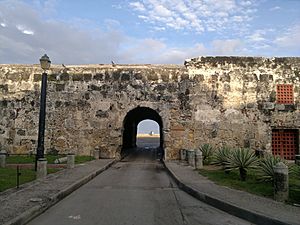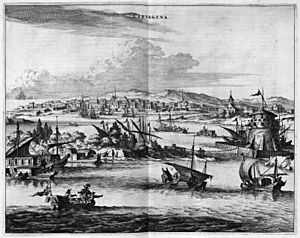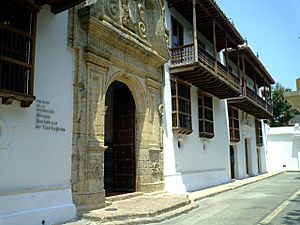Francisco de Murga facts for kids
Quick facts for kids
Francisco de Murga y Ortiz de Orué
|
|
|---|---|
| Governor of Cartagena | |
| In office 17 October 1629 – 17 July 1636 |
|
| Preceded by | Francisco Guzmán Luis Berrio (Acting) |
| Succeeded by | Antonio Maldonado de Tejeda (Acting) |
| Personal details | |
| Born | Artomaña |
| Died | 17 July 1636 Cartagena |
| Nationality | Spanish |
| Occupation | Soldier |
Francisco de Murga y Ortiz de Orué (born around 1570 – died 1636) was a Spanish soldier and engineer. He became an important leader, serving as the Governor and Captain-General of Cartagena. Before this, he was governor of Marmora in Africa. He was also a knight of the Order of Santiago.
Contents
Governor of Cartagena
Francisco de Murga was the governor of Cartagena from 1629 until he passed away in 1636. He took over from García Girón de Loayza.
Protecting the City
Cartagena was often in danger from Dutch privateers. These were like pirates who were allowed by their government to attack enemy ships. During his time as governor, Murga made the city's eastern defenses much stronger.
He had different ideas from an Italian engineer named Cristóbal de Roda Antonelli. Murga had experience building forts in Flanders (modern-day Belgium and Netherlands). He wanted to use new ways to protect the city. This included building special trenches and advanced walls called Ravelins to make it harder for enemies to get close.
In 1631, he used prisoners from English and French colonies to build a strong gatehouse. This gatehouse, called a Media Luna (half moon), connected the city to the Getsemaní area. Its special curved wall could quickly cut off the city from any attacks from the land. Because of his work on these strong walls, people called Murga the "master builder" of Cartagena. They even nicknamed him the "Marquis de las Murallas" (Marquis of the Walls).
Dealing with Providence Island
In 1630, English settlers created a colony on an island the Spanish called Santa Catalina. Today, it's known as Isla de Providencia, near Nicaragua. This settlement became a base for privateers who attacked Spanish ships.
The Spanish didn't know about this colony until 1635. That's when they captured some Englishmen in Portobelo, Panama. Governor Murga quickly sent Captain Gregorio de Castellar y Mantilla and engineer Juan de Somovilla Texada to destroy the colony.
In July 1635, the Spanish fleet arrived near the English settlement. Castellar asked the English to give up, but Governor Philip Bell refused. The Spanish tried to attack a weak spot, but the English fought back with gunfire. The Spanish were forced to leave quickly. Later, Murga sent his forces to find another English base, but they couldn't locate it.
The Maroon Communities
Murga also had to deal with the problem of Cimarrones, also known as Maroons. These were enslaved people from Africa who had escaped and formed their own independent villages. They sometimes raided and attacked both Native Americans and Spanish settlers in the Cartagena area.
There were at least eight Maroon villages, called palenques, in the region. In 1631, Murga sent soldiers to attack a palenque near the Magdalena River. They found it empty and burned it down.
In 1633, Murga tried to make peace with the Palenque of Limón. But when the talks failed, Spanish soldiers attacked Limón on December 9, 1633. They captured over eighty people. After a trial, thirteen Maroons were executed. Their bodies were displayed publicly as a warning. The detailed records from their trial, sent to King Philip IV of Spain, are now a very important historical document.
Disputes with the Inquisition
As governor, Francisco de Murga wanted to limit the power of the Inquisition. The Inquisition was a powerful religious court, and many people in Cartagena disliked it. Murga had strong disagreements with an inquisitor named Vélez de Asas y Argos.
The inquisitors wrote a letter in 1632, calling Murga "the most dangerous man on earth" because he constantly bothered them. One day, Murga even released a man who was being publicly punished by the Inquisition. Because of this, the inquisitors officially removed Murga from the church (excommunicated him). But Murga then put the officials who told him this in jail for a day!
Eventually, Murga asked to be forgiven. However, the way the forgiveness was given was very insulting. The Council of the Indies, a powerful Spanish government group, complained to the king. The inquisitor, Velez y Argos, was ordered to explain his actions in Madrid. Murga's death helped solve the problem. The council suggested to the king that Velez y Argos should not return to Cartagena, and the king agreed. Velez y Argos was later moved to another court in Mexico in 1637.
See also
 In Spanish: Francisco de Murga para niños
In Spanish: Francisco de Murga para niños




